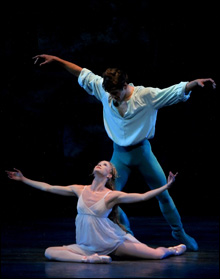
ROMEO + JULIET: Riding on rather than exploring Prokofiev’s music and Shakespeare’s play. |
NEW YORK — About the only question to ask about a new Romeo and Juliet, besides “Why?”, is “Why New York City Ballet?” Ever since its founding in 1948, NYCB has cultivated an identity as a company that does pure-dance ballets. Even earlier, as George Balanchine was gaining a foothold in America, he affronted the Metropolitan Opera, where his dancers were installed as the resident ballet, by doing avant-garde ballet evenings. His 1937 program of the all-Stravinsky, all-butplotless Apollo, Jeu de Cartes, and Le Baiser de la Fée was too unconventional, and the Met severed the relationship.
Myths and fairy tales weren’t the red meat of ballet, Balanchine thought, but he was versatile, adaptable. Along with Aida and Don Giovanni, he’d been choreographing things like the Ziegfeld Follies, and he kept his dancers working in his shows and movies for the next 10 years while the ballet company reconstituted itself for special purposes. Once established at New York City Center and then Lincoln Center, Balanchine’s NYCB shunned the prefabricated story ballets except to embrace them as moneymakers, like Nutcracker. His other adaptations of 19th-century stories were either stripped to the bone (Coppélia, Swan Lake (Act II)) or culled for their dance essence (La Sylphide as Scotch Symphony, for instance).
Now, 24 years after Balanchine’s death, as the company celebrates the 100th birthday of its even more æsthetically minded co-founder, Lincoln Kirstein, New York City Ballet has mounted a full-evening Romeo choreographed by its ballet-master-inchief, Peter Martins. I don’t know whether this means the company will turn to more costume spectaculars or whether it’s just another way station in Martins’s quest to supply the repertory with appealing items.
Martins initially got a lot of mileage out of his determination to cast students from the School of American Ballet for the leads. The ballet’s doomed lovers should be the same age as Shakespeare’s protagonists, he thought. This seemed like a pretty literal idea. Some of the iconic ballerina Juliets were created by Galina Ulanova at 30 in Leonid Lavrovsky’s version, Margot Fonteyn at 46 in Kenneth MacMillan’s, and Alicia Markova at 33 in Antony Tudor’s.
But the notion got a certain amount ofpress coverage for Martins and encouraged expectations of a really new treatment, one perhaps as trendy as his title for the ballet, Romeo + Juliet. As it turned out, the initial leading roles were played by corps de ballet member Robert Fairchild and NYCB new principal Sterling Hyltin. This couple were quite wonderful when I saw them on May 8 in the flights of adolescent ecstasy that Martins choreographed.
The production was indeed strippeddown compared to the scenic opulence and peripheral carryings-on of other versions. I think it was in MacMillan’s version, or possibly John Cranko’s, that the townspeople pitched into the first-act Montague/Capulet skirmish, lobbing oranges or anything else they could get their hands on. Martins eliminated the civilians and staged the opening clash of the clans as a formal dance for the color-coded corps, backing up the first of several splendidly coached episodes of swordplay.